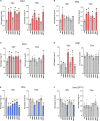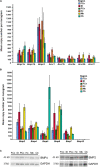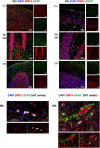Canonical Bone Morphogenetic Protein Signaling Regulates Expression of Aquaporin-4 and Its Anchoring Complex in Mouse Astrocytes
- PMID: 35518645
- PMCID: PMC9067306
- DOI: 10.3389/fncel.2022.878154
Canonical Bone Morphogenetic Protein Signaling Regulates Expression of Aquaporin-4 and Its Anchoring Complex in Mouse Astrocytes
Abstract
Aquaporin-4 (AQP4) is the predominant water channel in the brain; it is enriched in astrocytic foot processes abutting vessels where it is anchored through an interaction with the dystrophin-associated protein (DAP) complex. Enhanced expression with concomitant mislocalization of AQP4 along astrocyte plasma membranes is a hallmark of several neurological conditions. Thus, there is an urgent need to identify which signaling pathways dictate AQP4 microdistribution. Here we show that canonical bone morphogenetic proteins (BMPs), particularly BMP2 and 4, upregulate AQP4 expression in astrocytes and dysregulate the associated DAP complex by differentially affecting its individual members. We further demonstrate the presence of BMP receptors and Smad1/5/9 pathway activation in BMP treated astrocytes. Our analysis of adult mouse brain reveals BMP2 and 4 in neurons and in a subclass of endothelial cells and activated Smad1/5/9 in astrocytes. We conclude that the canonical BMP-signaling pathway might be responsible for regulating the expression of AQP4 and of DAP complex proteins that govern the subcellular compartmentation of this aquaporin.
Keywords: Smad1/5/9; aquaporin-4; astrocyte; bone morphogenetic protein; dystrophin.
Copyright © 2022 Skauli, Savchenko, Ottersen, Roybon and Amiry-Moghaddam.
Conflict of interest statement
The authors declare that the research was conducted in the absence of any commercial or financial relationships that could be construed as a potential conflict of interest.
Figures









Similar articles
-
BMP signaling alters aquaporin-4 expression in the mouse cerebral cortex.Sci Rep. 2021 May 18;11(1):10540. doi: 10.1038/s41598-021-89997-5. Sci Rep. 2021. PMID: 34006980 Free PMC article.
-
Isoflurane post-conditioning down-regulates expression of aquaporin 4 in rats with cerebral ischemia/reperfusion injury and is possibly related to bone morphogenetic protein 4/Smad1/5/8 signaling pathway.Biomed Pharmacother. 2018 Jan;97:429-438. doi: 10.1016/j.biopha.2017.10.082. Epub 2017 Nov 6. Biomed Pharmacother. 2018. PMID: 29091893
-
Anchoring of aquaporin-4 in brain: molecular mechanisms and implications for the physiology and pathophysiology of water transport.Neuroscience. 2004;129(4):999-1010. doi: 10.1016/j.neuroscience.2004.08.049. Neuroscience. 2004. PMID: 15561415 Review.
-
Bone morphogenetic proteins.Growth Factors. 2004 Dec;22(4):233-41. doi: 10.1080/08977190412331279890. Growth Factors. 2004. PMID: 15621726 Review.
-
BMP signaling in astrocytes downregulates EGFR to modulate survival and maturation.PLoS One. 2014 Oct 17;9(10):e110668. doi: 10.1371/journal.pone.0110668. eCollection 2014. PLoS One. 2014. PMID: 25330173 Free PMC article.
Cited by
-
BMP10 accelerated spinal astrocytic activation in neuropathic pain via ALK2/smad1/5/8 signaling.Front Pharmacol. 2024 Aug 12;15:1426121. doi: 10.3389/fphar.2024.1426121. eCollection 2024. Front Pharmacol. 2024. PMID: 39188955 Free PMC article.
-
Crosstalk between bone and brain in Alzheimer's disease: Mechanisms, applications, and perspectives.Alzheimers Dement. 2024 Aug;20(8):5720-5739. doi: 10.1002/alz.13864. Epub 2024 Jun 2. Alzheimers Dement. 2024. PMID: 38824621 Free PMC article. Review.
-
Role of aquaporins in brain water transport and edema.Front Neurosci. 2025 Jan 29;19:1518967. doi: 10.3389/fnins.2025.1518967. eCollection 2025. Front Neurosci. 2025. PMID: 39944892 Free PMC article. Review.
-
The Role of Aquaporins in Epileptogenesis-A Systematic Review.Int J Mol Sci. 2023 Jul 25;24(15):11923. doi: 10.3390/ijms241511923. Int J Mol Sci. 2023. PMID: 37569297 Free PMC article.
-
The potential link between the development of Alzheimer's disease and osteoporosis.Biogerontology. 2025 Jan 20;26(1):43. doi: 10.1007/s10522-024-10181-z. Biogerontology. 2025. PMID: 39832071 Free PMC article. Review.
References
-
- Amiry-Moghaddam M., Xue R., Haug F. M., Neely J. D., Bhardwaj A., Agre P., et al. (2004b). Alpha-syntrophin deletion removes the perivascular but not endothelial pool of aquaporin-4 at the blood-brain barrier and delays the development of brain edema in an experimental model of acute hyponatremia. Faseb J. 18 542–544. 10.1096/fj.03-0869fje - DOI - PubMed
-
- Amiry-Moghaddam M., Williamson A., Palomba M., Eid T., de Lanerolle N. C., Nagelhus E. A., et al. (2003b). Delayed K+ clearance associated with aquaporin-4 mislocalization: phenotypic defects in brains of alpha-syntrophin-null mice. Proc. Natl. Acad. Sci. U.S.A. 100 13615–13620. 10.1073/pnas.2336064100 - DOI - PMC - PubMed
-
- Amiry-Moghaddam M., Otsuka T., Hurn P. D., Traystman R. J., Haug F. M., Froehner S. C., et al. (2003a). An alpha-syntrophin-dependent pool of AQP4 in astroglial end-feet confers bidirectional water flow between blood and brain. Proc. Natl. Acad. Sci. U.S.A. 100 2106–2111. 10.1073/pnas.0437946100 - DOI - PMC - PubMed
LinkOut - more resources
Full Text Sources

